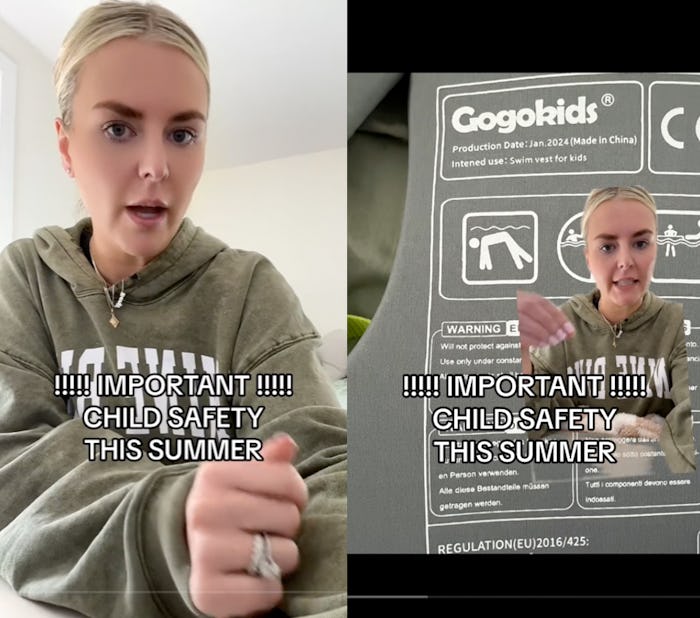Water Safety

If You’ve Ever Bought A Kids’ Life Jacket On Amazon, You Need To See This Tik Tok
Excuse me, does that say “will not protect against drowning”?
Why do we buy life jackets for our kids? To prevent the tragedy that is drowning, of course. So imagine one mom’s surprise when a loved one pointed out the life jacket she’d just purchased for her child would not actually keep her safe. Allie Wojciak, a content creator with almost 18,000 followers on TikTok, recently shared her story as a PSA to parents who might also be buying life jackets online.
In her video, Wojciak says with summer coming in hot, she wanted to get a life jacket for her son. She opened Amazon, searched “toddler life jacket,” and ultimately purchased one with lots of good reviews. Her father-in-law happened to be at her house when the life jacket arrived. He took a look at the life vest and told Wojciak she shouldn’t use it. When she took a closer look, she saw why: the inside of the life jacket includes a warning label that says the jacket “will not protect against drowning.” It is only intended to be used as a swim vest. She returned the jacket and instead purchased one that is U.S. Coast Guard-approved, she says. Wojciak did the right thing, according to water safety experts, who recommend children only be put in life jackets that are approved by the Coast Guard, as Romper previously reported.
As for the life jacket and swim vest verbiage, they sound like synonyms, but they’re actually different products. Swim vests are designed to make the swimmer more buoyant, but they won’t keep the wearer’s head above water in an emergency — they would still have to tread water to do that. Coast Guard-approved life jackets are designed to keep kids’ heads above water in a crisis, regardless of their ability to swim, float, or tread water. These jackets will be labeled by type, and the type you need depends on your child’s swimming skills and the activities they’ll be doing around the water. Here’s the breakdown:
- Type I: This kind of life vest is intended for “all waters, open ocean, rough seas, or remote water.” They are designed to roll the wearer face-up in the water, even if they are unconscious. This is especially important for young children and weak swimmers, experts say.
- Type II: The Coast Guard suggests these life vests for “general boating activities” and swimming in “calm, inland waters.” Type IIs differ from Type Is because some will roll the wearer face up, but not all, so keep that in mind when shopping.
- Type III: These life jackets are intended for general boating, kayaking, water skiing, and other water sports. They’re designed to be less bulky and offer more range of motion. They’ll hold the wearer upright in the water, but they’ll need to have some swimming savvy and the ability to tread water, or they risk getting stuck face down.
Once the life jacket you ordered arrives, double check the labels to ensure it really is Coast Guard-approved (those Amazon sellers can’t always be trusted), and ensure the weight limit on the label is right for your child. You may also want to brush up on how to properly fit a life jacket to your child so you know the vest will do its job if the need arises.
It’s frustrating to have to be this diligent when it comes to buying products to keep our kids safe. That said, you’ll never regret doing that extra bit of due diligence so you know without a doubt your child’s life jacket will, in fact, help prevent drowning. You know, the thing you bought it to do.